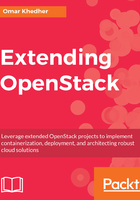
Ansible in a nutshell
According to the new trend of cloud infrastructure developers, every operational task must be capable of automation. Many system management tools offer automation capabilities and have been extended to cover more advanced features, such as emulating parts of a given system for a fast file definition validation. Of course, every infrastructure tool must show its capability of making an easy-to-use, realistic full test and deployment. Compared to Chef or Puppet, for example, Ansible could be reckoned to be the simplest form of IT orchestration and automation tool. This is because Ansible does not require any agent or daemon to be running on the managed host or instance. It simply needs a Secure Shell connection, and then all it needs to do is copy the Ansible modules to the managed hosts and execute them, and that is it!
By the virtue of its simplicity, agentless architecture, deploying and expanding a large OpenStack infrastructure becomes much less complicated. Ansible uses playbooks to modularize its definition configuration files written in the YAML markup format.
As with Chef or Puppet, configuration files in Ansible are organized in a specific definition layered hierarchy, as follows:
- Playbook: A Playbook can be seen as a high level code of the system deployment. The code instructs which host or group of hosts will be assigned to which role. It encapsulates a few specific parameters to enable Ansible run user as root for example.
- Role: A role represents the intended logical function of a host or group of hosts. The role file exposes tasks and customized functions to configure and deploy a service in one or a fleet of hosts.
- Module: Another good reason that proves the simplicity of Ansible is the usage of modules. Basically, a module comes with a predefined encapsulated code that is ready to run against a target host. Running a module many times against a host will take effect only when a change is explicitly made. Besides the current modules available at http://docs.ansible.com/ansible/latest/modules_by_category.html, you can always create and customize your own modules in other languages.
- Variable: Defining variables in Ansible is straightforward from Playbooks, Modules, or Roles. When dealing with OpenStack deployment, defining, and setting variable placeholders must be done with care for a safe, dynamic change of the system's attributes.
- Facts: Another interesting part of the Ansible workflow is the gathering of the facts of the target system when executing a playbook against it. The information about the system, such as network configuration, operating system, and other low-level details, will be saved in a variable named facts. By default, Ansible captures the target system details unless you explicitly disable this in the Playbook.
- Inventory: Ansible will need a list of hosts to run the coded playbooks against. This is where the inventory comes for a collection of nodes defined by their IP addresses, hostnames, or Fully Qualified Domain Name (FQDN). The inventory list is an INI formatted file named simply hosts, and is located by default in the Ansible server under the /etc/ansible/ directory. Ansible comes with two different approaches to gathering different hosts inventory. These are described as follows:
- Static inventory: This elaborates the inventory list manually in a single defined host or into groups.
- Dynamic inventory: When it comes to a large number of nodes in a production OpenStack setup, Ansible offers a better way to handle this situation. It is possible to create an inventory script collector and invoke it to pull host information at runtime.
